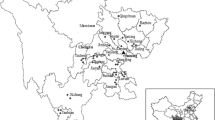Abstract
Glycine canescens, G. tabacina, andG. tomentella were used to trap rhizobia from American soils. Rhizobia recovered from these nodules then were compared with isolates from plants that had been naturally nodulated in Australia. All isolates were mucoid and gave alkaline reactions on yeast extract-mannitol medium. Two American isolates fromG. tabacina were noticeably stringy. The nodulating abilities of 13 isolates, including four from Australia, were examined. All nodulatedAeschynomene americana, Vigna unguiculata, andMacroptilium atropurpureum. With one exception, each isolate also nodulated all threeGlycine spp. Tests with a series of slow-growing reference strains suggest thatG. tomentella nodulates more promiscuously thanG. tabacina andG. canescens. All three plant species are infected via infection threads produced in short, curled root hairs.
Similar content being viewed by others
References
Allen O N and Allen E K 1981 The Leguminosae. Univ. Wisconsin Press, Madison, pp 302–305.
Appelbaum E R, Johansen E and Chartrain N 1985a Symbiotic mutants of USDA 191, a fast-growing Rhizobium that nodulates soybeans. Mol. Gen. Genet. 201, 454–461.
Appelbaum E R, McLoughlin T J, O'Connell M and Chartrain N 1985b Expression of symbiotic genes ofRhizobium japonicum USDA 191 in other rhizobia. J. Bacteriol. 163, 385–388.
Brockwell J, Diatloff A, Grassia A and Robinson A C 1975 Use of wild soybean (Glycine ussuriensis Regel and Maack) as a test plant in dilution-nodulation frequency tests for countingRhizobium japonicum. Soil Biol. Biochem. 7, 305–311.
Devine T E 1987 A comparison of rhizobial strain compatibilities ofGlycine max and its progenitor speciesGlycine soja. Crop Sci. 27, 635–639.
Diatloff A and Ferguson J E 1970 Nodule numnber, time to nodulation and its effectiveness in eleven accessions ofGlycine wightii. Trop. Grasslands 4, 223–228.
Du Teau N M, Palmer R G and Atherly A G 1986 Fast-growingRhizobium fredii are poor nitrogen-fixing symbionts of soybean. Crop Sci. 26, 884–889.
Heron D S and Pueppke S G 1984 Mode of infection, nodulation specificity, and indigenous plasmids of 11 fast-growingRhizobium japonicum strains. J. Bacteriol. 160, 1061–1066.
Hymowitz T and Newell C A 1980 Taxonomy, speciation, domestication, dissemination, germplasm resources and variation in the genus Glycine. Adv. Legume Sci. 251–264.
Keyser H H and Cregan P B 1984 Interactions of selectedGlycine soja Sieb. and Zucc. genotypes with fast- and slow-growing soybean rhizobia. Crop Sci. 24, 1059–1062.
Keyser H H, Bohlool B B, Hsu T S and Weber D F 1982 Fast-growing rhizobia isolated from root nodules of soybean. Science 215, 1631–1632.
Lim S M and Hymowitz T 1987 Reactions of perennial wild species of genus Glycine toSeptoria glycines. Plant Dis. 71, 891–893.
Meyer M C and Pueppke S G 1980 Differentiation ofRhizobium japonicum strain derivatives by antibiotic sensitivity patterns, lectin binding, and utilization of biochemicals. Can. J. Microbiol. 26, 606–612.
Newell C A and Hymowitz T 1980 A taxonomic revision in the genus Glycine subgenus Glycine (Leguminosae). Brittonia 32, 63–69.
Newell C A and Hymowitz T 1982 Successful wide hybridization between the soybean and a wild perennial relative,G. tomentella Hayata. Crop Sci. 22, 1062–1065.
Nutman P S 1980 Hereditary host factors affecting nodulation and nitrogen fixation.In Current Perspectives in Nitrogen Fixation. Eds. A H Gibson and W E Newton. pp 194–204. Australian Academy of Science, Canberra.
Pueppke S G 1983 Rhizobium infection threads in root hairs ofGlycine max (L.) Merr.,Glycine soja Sieb. & Zucc., andVigna unguiculata (L.) Walp. Can. J. Microbiol. 29, 69–76.
Pueppke S G and Hymowitz T 1982 Screening the genus Glycine subgenus Glycine for the 120,000 dalton seed lectin. Crop Sci. 22, 558–560.
Rolfe B G and Gresshoff P M 1980Rhizobium trifolii mutant interactions during the establishment of nodulation in white clover. Aust. J. Biol. Sci. 33, 491–504.
Scholla M H and Elkan G H 1984Rhizobium fredii sp. nov., a fast-growing species that effectively nodulates soybeans. Int. J. Syst. Bacteriol. 34, 484–486.
Singh R J and Hymowitz T 1985 An intersubgeneric hybrid betweenGlycine tomentella Hayata and the soybean,G. max (L.) Merr. Euphytica 34, 187–192.
Trinick M J 1982 Host-Rhizobium associations.In Nitrogen Fixation in Legumes. Ed. J M Vincent. pp 111–112. Academic Press, Sydney.
Vincent J M 1977Rhizobium: general microbiology.In A Treatise on Dinitrogen Fixation. Section III. Biology. Eds. R F W Hardy and W S Silver. pp 277–366. Wiley-Interscience, New York.
Author information
Authors and Affiliations
Rights and permissions
About this article
Cite this article
Pueppke, S.G. Nodulating associations among rhizobia and legumes of the genus Glycine subgenus Glucine. Plant Soil 109, 189–193 (1988). https://doi.org/10.1007/BF02202083
Received:
Revised:
Issue Date:
DOI: https://doi.org/10.1007/BF02202083




